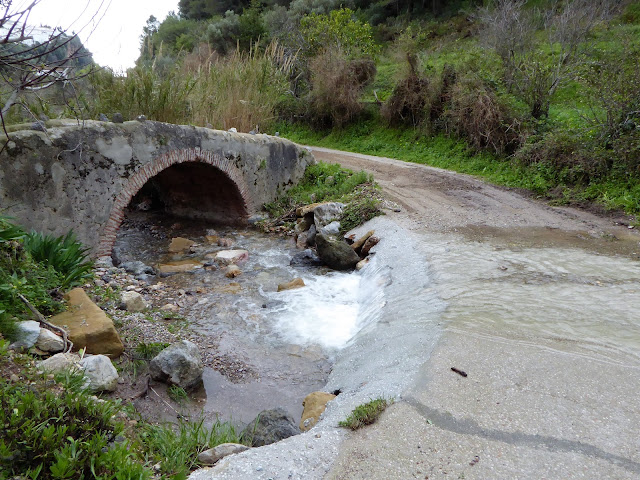 |
| Unusual to find this renovated hut on the walk up |
At the top, there is a visitors centre and from here you can take a choice of 2 walks ( a short and a long route) taking you
around El Torcal. We chose the
long one (3.5kms), not wanting to miss anything!
 |
| Watch your step Mel! |
The El Torcal rock formation has been formed as a result of an
accumulation of shells and skeletons of marine animals deposited on the floor
of the sea, that covered this area during the Jurassic period – approximately 200
million years ago. Then, around 20 million
years ago the sediments were compressed, deformed and fractured until they
emerged slowly into this incredible landscape. Due to
weathering and erosion, the rocks are constantly changing resulting in this impressive landscape.
 |
| Found this little fella hiding in the rocks on the way back down to the car park |
When we got back down to the car park, about
6.30pm the car park was empty. We were
tempted to wild camp here for the night as the views were stunning.
However, we had heard from other motorhomers that
you can get moved on and so decided to head back down to the Aire at Antequera
for the night, which now was overflowing
– 36 of us on an Aire that only takes 18!
The downside was it was very noisy as the Spanish motorhomers seemed to
want to party into the night – so we didn’t get much sleep.
The next day we moved on to an Aire at Campillos
(N37.04282 W4.863490), only 33kms west in the direction of Ronda. It's a pretty drive and was lined both sides virtually all the way with olive trees, new and old as far as the eye could see. They like their olives and olive oil in Spain!
It's a small and very quiet Aire (takes 6) with all facilities. The weather was hot, so we didn’t want to be sat in Sonny too long. It is a sleepy little town, with not much going on. The nicest area is just off the town’s central plaza, with a little garden and church but not an awful lot more to see.
It's a small and very quiet Aire (takes 6) with all facilities. The weather was hot, so we didn’t want to be sat in Sonny too long. It is a sleepy little town, with not much going on. The nicest area is just off the town’s central plaza, with a little garden and church but not an awful lot more to see.
It was a nice day to relax though and give Sonny a good ‘spring clean’. We got talking to an English guy from Nottingham
who brought a 4 bed house here in 2005 for €145,000 close to the Aire. He has
been living here on and off since then and said he couldn’t sell even if he
wanted as it is now only worth €90. All thanks to the mess those banks got us
in!
The Aire (N36.75188 W5.14798) is new and they are
still finishing it off in parts. For €10 you get everything including Wi-Fi and there is even
somewhere to wash and hoover out your motorhome for an extra €1, and a dedicated dog walking area – well done
Ronda!
A 30 minute walk from the Aire and we were at
Puente Neuvo. Ronda
is one of the most ancient cities in Spain, built on a rock that is
spectacularly split by the 120 metre deep Tajo gorge. Both sides are joined by
the 18th century Puente Nuevo (bridge).
 |
| Puente Nuevo |
 |
| A long and steep walk down - Puente Nuevo |
Ronda's bullring is an elegant double-tiered arcade of Tuscan columns, constructed in sandstone. It is the widest in the world and one of the oldest in Spain. Ronda is the birthplace of bull fighting, the first fight took place in 1785. It now stages only a few prestigious fights a year;
 |
| Bullring, Ronda |
Mel decided to give me his best pose as a bull fighter - Mmm, I don't think he has quite got the look I was hoping for!
Palacio de Mondragon – one of Ronda’s most beautiful palaces, dating from 1314
Palacio de Mondragon – one of Ronda’s most beautiful palaces, dating from 1314
 |
| Iglesia de Santa Maria la Mayor |
Sally x



























































